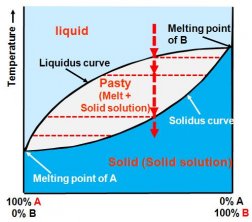 Soldering is the connection of two metallic materials using molten metal or a liquid alloy. The soldered region is heated to the point where the solder melts completely. The solder then has the characteristics of a liquid which spreads over the surface via capillary action. Solder molecules diffuse into the metal surface of the components to be soldered and a thin layer of an alloy is created.
Soldering is the connection of two metallic materials using molten metal or a liquid alloy. The soldered region is heated to the point where the solder melts completely. The solder then has the characteristics of a liquid which spreads over the surface via capillary action. Solder molecules diffuse into the metal surface of the components to be soldered and a thin layer of an alloy is created.
Figure 1. Soldering
The pieces of metal are connected after the source of heat is removed and the solder cools down to the point of solidification.
In order for the diffusion process to take place, both metal surfaces must be clean and free of oxides. Fluxing agents are therefore used to clean the surfaces. These fluxing agents are activated once the materials are warmed for soldering. The fluxing agents protect the surfaces from re-oxidation during the soldering process. Most fluxing agents must be removed after soldering since they produce reducing gases and are corrosive. void free connection is by applying a vacuum as soon as the solder is liquidized. For industrial production, protective gas can be used to achieve better coverage.
void free connection is by applying a vacuum as soon as the solder is liquidized. For industrial production, protective gas can be used to achieve better coverage.
Phase Diagram of Solder Material
Solder is made up of two metals that can mix without leaving voids. The solder is always solid at values below the solidus temperature and liquid at temperature aboves the liquidus temperature. The solder is "pasty" at temperatures that lie within the region between the solidus and liquidus temperatures.

Figure 2. Typical phase diagram for solder material
Solder can also be made up of two metals with an eutectic mixture of both metals. For the eutectic composition of the soldering alloy, the solidus and liquidus curves fall alongside each other such that the entire solder melts and solidifies at the eutectic temperature. The eutectic mixture is a fine crystal paste made of pure components of metal A and metal B.
Figure 3. Phase diagram for eutectic system
Solder comes in two main forms - as preforms and as soldering paste. The soldering paste is a suspension of soldering powder and a liquid. This liquid can either be soluble in water or in some other agent that is used in conjunction with the soldering powder.
Soldering agents
The main components of solder that are normally used in semiconductors are lead (Pb) or tin (Sn). Lead solder that contains a small percentage of tin and/or silver has a melting point of 280°C - 320°C. These solders are usually ductile and have good thermal stability. Tin solder, on the other hand, that contains 1% - 3% silver and/or copper (and sometimes











